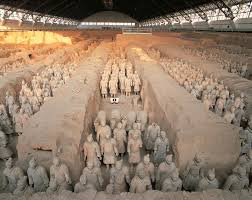
What Was Discovered in the Terracotta Army Tomb?
The Terracotta Army is one of the most significant archaeological discoveries of the 20th century. It is a vast collection of life-sized terracotta sculptures depicting the armies of Qin Shi Huang, the first emperor of China. The figures, dating back to the late 3rd century BC, were buried with the emperor in his mausoleum to protect him in the afterlife.
The Terracotta Warriors and Horses
The most iconic finds within the mausoleum complex are undoubtedly the thousands of terracotta soldiers, archers, and cavalrymen. Each figure is unique, with individual facial features, hairstyles, and armor. The sheer scale of the army is staggering, with an estimated 8,000 soldiers, 130 chariots with 520 horses, and 150 cavalry horses unearthed from the three main pits.
The warriors were originally painted in bright colors, remnants of which indicate the meticulous detail and craftsmanship involved in their creation. The variation in their ranks, uniforms, and weaponry provides valuable insights into the military organization of the Qin dynasty.
Weapons and Chariots
Beyond the figures themselves, the pits also held a vast array of bronze weapons and chariots. Thousands of bronze arrowheads, spearpoints, swords, and crossbow triggers have been discovered, many still sharp and in pristine condition. The presence of these weapons highlights the advanced bronze casting techniques of the time.
The bronze chariots, some of which were pulled by four horses, are equally impressive. These chariots were state-of-the-art war machines, showcasing the wealth and technological prowess of the Qin empire.
Accompanying Pits and Burial Tombs
The three main pits housing the warriors are just a small part of a much larger complex. Nearly 200 accompanying pits have been discovered around the tomb mound, containing a treasure trove of artifacts that shed light on life in the Qin dynasty. These pits contain:
- Terracotta acrobats, musicians, and officials: These figures provide a glimpse into the courtly life and entertainment of the era.
- Bronze waterfowl and other animals: These sculptures, possibly representing the emperor's hunting park, illustrate the artistry and attention to detail prevalent at the time.
- Burial tombs of high-ranking officials and concubines: These tombs offer further insights into the burial practices and social hierarchy of the Qin dynasty.
Architectural Remains
The Terracotta Army site also includes the remains of palaces, offices, workshops, and other structures. These architectural remnants provide valuable information about the construction techniques and urban planning of the Qin dynasty. The scale and complexity of the mausoleum complex itself are a testament to the power and ambition of Qin Shi Huang.
FAQs
Q: When was the Terracotta Army discovered?
A: The Terracotta Army was discovered in 1974 by farmers digging a well near Xi'an, China.
Q: Why was the Terracotta Army built?
A: The army was built to accompany the first emperor of China, Qin Shi Huang, in the afterlife and to protect him from his enemies.
Q: How many warriors are there in total?
A: It is estimated that there are over 8,000 terracotta warriors, along with horses, chariots, and other figures, buried within the mausoleum complex.